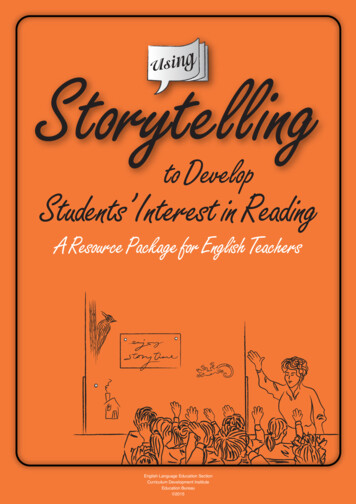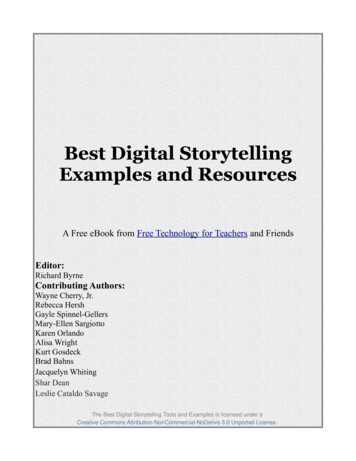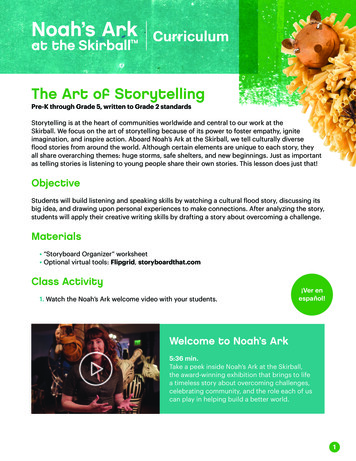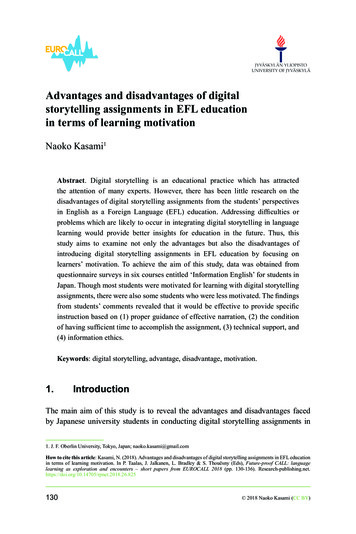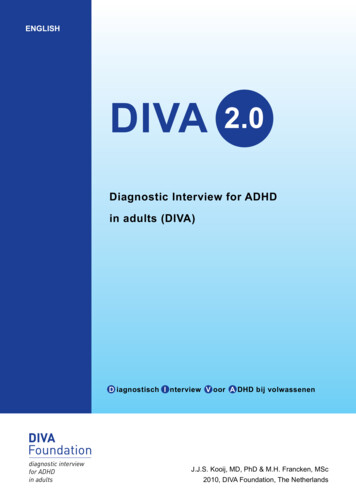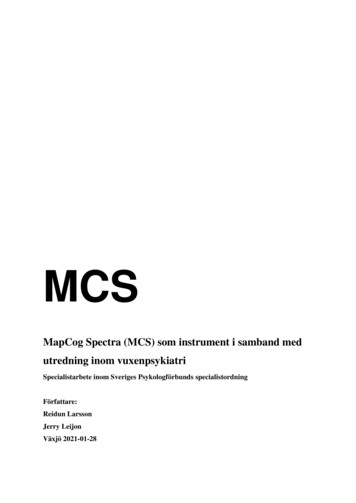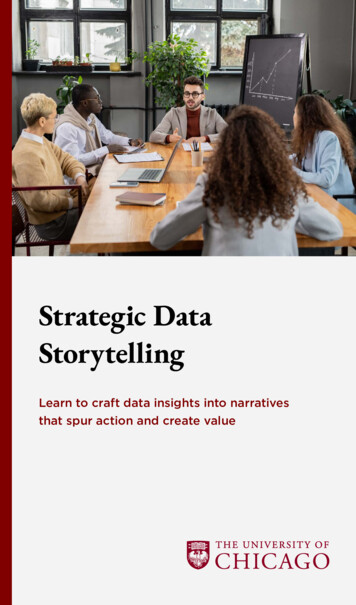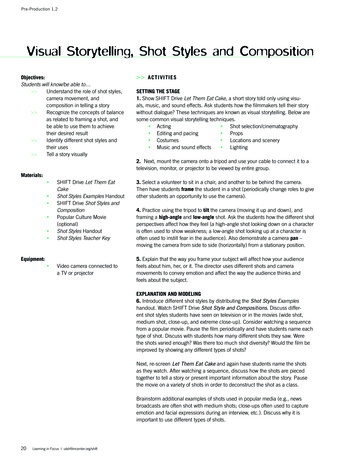
Transcription
December 2010Storytelling and Destination Development Possibilities and drawbacks of using storytelling as a means of developing and marketing Nordictourism destinationsFive selected Nordic casesAuthors: Lena Mossberg, Anette Therkelsen, Edward H. Huijbens, Peter Björk, Anna Karin Olsson
List of participants:Dr. Lena Mossberg, Norwegian School of Management, Oslo, NorwayDr. Anette Therkelsen, Tourism Research Unit, Aalborg University, DenmarkDr. Edward H. Huijbens, Icelandic Tourism Research Centre, Akureyri, IcelandDr. Peter Björk, Hanken School of Economics, Vaasa, FinlandLecturer Anna Karin Olsson, University West, Trollhättan, SwedenAuthors of the cases:Norway:Lecturer Anna Karin OlssonDenmark:Dr. Anette Therkelsen & research assistant Jacob R.K. LarsenIceland:Dr. Edward H. Huijbens & research assistant Björg ÁrnadóttirSweden:Dr. Lena Mossberg & research assistants Eva Forslund, Jenny Nilsson, Jenny Bui, MyWrethagenFinland:Dr. Peter Björk & research assistant Hanna PettinenII
Title: Storytelling and destination developmentNordic Innovation Centre (NICe) project number: 08041Authors: Lena Mossberg, Anette Therkelsen, Edward H. Huijbens, Peter Björk and AnnaKarin OlssonInstitutions: Norwegian School of Management, Oslo, Norway. Tourism Research Unit,Aalborg University, Denmark. Icelandic Tourism Research Centre, Akureyri, Iceland. HankenSchool of Economics, Vaasa, Finland. University West, Trollhättan, Sweden.Abstract:The objective of this study is to scrutinize the possibilities and drawbacks of using storytellingas a means of developing and marketing Nordic tourism destinations. On the basis of fiveselected Nordic cases, the study sheds light both on the ways in which storytelling is practicedand how stakeholder cooperation unfolds and seeks to determine the prerequisites for usingstorytelling as part of a destination development strategy. Drawing on the literature onstorytelling as well as theory on inter-organisational relations, the study develops a theoreticalmodel which centres on four closely interrelated elements: types of stakeholders involved;stages of the storytelling process; outcome of the storytelling process; and destinationdevelopment. The theoretical model serves as a central tool for the cases presented toillustrate the issues at stake.The five cases consist of rich sets of data: interviews with main stakeholders; collection ofindustry documents, marketing material and media coverage; observation of stakeholdermeetings; and participant observation of storytelling events. The findings point to theimportance of a location-based story to conceptualize, substantiate, and commercialize adestination. Findings suggest that some cases are characterized by individual stories of manyqualities in terms of dramaturgical principles and customer involvement, however, an overallstory framework is non-existent which makes the storytelling initiative poorly suited as ameans of destination development. In other cases, a more holistic, coordinated story can beidentified that ties the individual stories together and on this basis a common identity for thedestination seems to materialize. The nature of stakeholder relations helps explain why somestorytelling practices have destination development potential whereas others have not.Dedicated leadership, multi-actor involvement and two-way communication appear to beprerequisites for the destination development potential of storytelling activities.Topic/NICe Focus Area: Tourism industryLanguage: EnglishPages: 65Keywords: Storytelling practices, stakeholder cooperation, destination development, 5 Nordiccases.Distribution by: Nordic Innovation Centre, Stensberggata 25, NO-0179 Oslo, Norway.Contact person: Lena Mossberg, Norwegian School of Management, Oslo, Norway / Schoolof Business, Economics and Law at University of Gothenburg, PO Box 610, SE 405 30Gothenburg, Sweden, 46 317 861 539, lena.mossberg@handels.gu.se, www.handels.gu.se.III
Executive summaryThe objective of the project:The objective of this study is to scrutinize the possibilities and drawbacks of using storytellingas a means of developing and marketing Nordic tourism destinations. On the basis of fiveselected Nordic cases, the study sheds light both on the ways in which storytelling is practicedand how stakeholder cooperation unfolds and seeks to determine the prerequisites for usingstorytelling as part of a destination development strategy.The study has achieved this objective by:- Producing five Nordic case analyses on specific storytelling destination based onqualitative research methods.- Developing a theoretical model which establishes an understanding of destinations aslaced with stories and how stories can form constituent parts of destination marketingand development.- Giving a critical view on possibilities and drawbacks of storytelling in destinationdevelopment with particular focus on storytelling practices and stakeholder cooperation.- Learning from experience across Nordic destinations through comparative analysis.- Working in close cooperation with selected stakeholders and disseminating knowledgefrom the case studies.Method:The empirical data collected relate to five different cases, one from each Nordic country, andfocus on various tourism-related storytelling efforts. The five cases are at different stages,some in their introduction stage, others in growth or maturity stages of development.Interviews were conducted with all in all 83 stakeholders, in addition to a number of informaltalks with both stakeholders and visitors from the five case study areas. These werecomplemented with desk research analysing industry documents, marketing material andmedia coverage in relation to each case. Furthermore, observations of storytelling practisesand stakeholder meetings have been carried out in the Danish, Swedish, Norwegian andIceland cases. The Finnish case was in a start up phase and no observations could beconducted, instead field studies of potential storytelling areas were practiced. For the Swedishcase, a quantitative questionnaire study of 52 respondents with focus on visitors‟ experiencescomplemented the interviews. Based on thorough analyses, critical moments in thestorytelling processes are identified and analyzed from a development and marketingperspective. The research group has worked in close contact with both public and privatestakeholders in each case during the data collection process.Main results:The theoretical model of this research project is founded in storytelling literature, primarilymarketing related contributions, as well as theory on inter-organisational relations andrevolves around four closely interrelated elements: types of stakeholders involved; stages ofthe storytelling process; outcome of the storytelling process; and destination development.Based on this model, storytelling is depicted as a multi-actor, multi-level process leading todestination development. A story, on which a storytelling approach is founded, has to be: a)accepted by those who are involved in the storytelling process, b) location-based and, c)subject to conceptualization and commercialization.IV
A constituent part of conceptualization and commercialization is to establish a narrativeenvironment where co-production between stakeholders and customers is central as thisensures customer involvement and a richer destination experience. The process orientedtheoretical model proclaims the significance of strong leadership and stakeholder participationand involvement. The importance of seamless communication in all directions cannot be overemphasized. An equally vital aspect is the preservation of a core group of enthusiasts whoenergise the development process.In general, the cases analyzed are characterised by individual stories of many qualities forinstance in terms of high level of engagement on the part of the individual storytellers, usingdramaturgical principles, sense stimulation and achieving customer involvement. However,not on all dimensions and in all aspects are the cases exemplary. Especially the link betweenstorytelling and destination development is less developed in some of the cases, whichindicates that skilful storytelling practices are not sufficient for storytelling to function as ameans of destination development. Excluding the storytellers and storytelling locations fromthe strategic decisions of a storytelling planning process, as well as lack of interactionhorizontally among storytellers is a serious limitation to storytelling as a destinationdevelopment tool. In other cases a relatively holistic coordinated story can, however, beidentified that ties individual stories together and on this basis a common identity for thedestination evolves. These cases are typically characterised by flat organisational structureswhere information flows freely facilitating ongoing learning processes. All five casesdemonstrate the potential for innovative destination development through a storytellingapproach, however, whereas some cases realise this potential others do not due to less thanoptimum strategic planning and stakeholder relations.ConclusionsIn each Nordic country, stories exist on which a storytelling approach to destinationdevelopment and marketing can be based. The lessons learned and practices suggested are:1. A storytelling approach used for destination development and marketing is a longterm, multi-actor, multi-level process. All stakeholders and all activities have to be intune with the storyline.2. In order for the storytelling effort to have an impact on destination development, thedestination management organisation (DMO) must establish active and on-goingcollaborative linkages with the tourism industry of the region3. A level of theatrical expertise is necessary in order to successfully communicate thestories both verbally and through displays. Such expertise can facilitate high level ofinteraction between visitors and storytellers.4. Storytelling efforts may facilitate local community building and thus be important fordestination development.RecommendationsRecommendations for practitioners:Stories can act as a framework for coordinating and packaging activities, transportation,accommodation and dining if they communicate the core values and attributes of a destinationin an understandable way. Here, the story becomes a verbal and visual metaphor which showsthe total offering. Advantages from the destination and companies‟ perspective are: The destinations and companies themed through storytelling can gain visibility in theoverall marketing of a destination and a region. There might be a multitude ofV
companies on each given marketing portal, however, the companies with a story havea chance to stick out.It makes it easy for the companies to communicate with each other in a networkestablished around a storyline.The collaboration around a storyline can offer an ideal framework for the companiesto develop and test new products on the market.All companies involved in the storytelling and storylines development can be visible,no matter size, economy and reputation.A story about the destination can give the destination a unique competitive advantage.Recommendations for further studies:1. Five different cases in the Nordic countries were analyzed in this project. A follow-upstudy may focus on ways in which Nordic storytelling destinations could be packagedand branded. Different story themes such as history, food, nature, architecture could beanalyzed.2. A central aspect of storytelling and destination development is customer involvementand active participation. There is paucity in our understanding of who wants to beimmersed in the service experience processes and in what way, and when. Thesequestions could be linked to customer segmentation.3. It would be instructive to study the communicative strategies of storytelling in moredetails. On the basis of recordings of storytelling activities, techniques both forbuilding a story line and for interacting with the audience may be outlined, and thiscould form an important basis for product development in future.4. Further studies could explore the ways in which a research-based approach to culturalheritage can complement and be fruitfully combined with storytelling destinationdevelopment.5. It would, furthermore, be relevant to scrutinize the dynamics of collaboration around aspecific theme of storytelling and how private tourism service providers couldintegrate the theme of the storytelling destination into their products.6. The knowledge dynamics of storytelling networks would be highly interesting to studyin further detail, as knowing how networks get wiser is an important tool for futuredevelopment. To what extent do storytelling networks use, share and generateknowledge and at what levels of the network does this take place; do they make use oflocal and/or distant knowledge sources; and what types of knowledge are put to use?VI
Table of ContentsList of ParticipantsExecutive SummaryTable of Contents1. Introduction .1.1. Background .1.2. The objective of the project .1.3. Selection of the cases . .11222. Theoretical Model on Storytelling and Destination Development .43. Five Nordic Storytelling Cases .73.1. The Norwegian Case: The Medieval Week in Numedal 3.1.1. Background – the creation of the Medieval Week 3.1.2. Organisation and stakeholders .3.1.3. Understanding and application of storytelling .3.1.4. Destination development .3.1.5. Analysis of the Medieval Week 8891112133.2. The Danish case: The Tales of Limfjorden .3.2.1 Background .3.2.2. Organisation and stakeholders .3.2.3. Understanding and application of storytelling .3.2.4. Destination development .3.2.5. Analysis of Tales of Limfjorden .1718192022233.3. The Icelandic Case: The Settlement Centre of Iceland .3.3.1. Introduction .3.3.2. Background .3.3.3. Organisation and stakeholders .3.3.4. Storytelling practice .3.3.5. Destination development .3.3.6. Analysis of the Settlement Centre.3.3.7. Concluding points .26262728293131333.4. The Swedish case: The shellfish journey .3.4.1. Background .3.4.2. Organisation and stakeholders .3.4.3. Storytelling practice .3.4.4. Destination development and the Shellfish Journey3.4.5. Analysis of the Shellfish Journey .3334343536373.5 The Finnish case: The Neanderthal Family .3.5.1. Background and prerequisites .4142VII
3.5.2. Organisation and stakeholders .3.5.3. Storytelling practice .3.5.4. Analysis of the Neanderthal family.4344453.6 Comparison across cases .474. Conclusions . 4.1. Theoretical concepts revisited .4.2. Business implications .4.2. Society implications 50505152Publications from the project .53References . 53VIII
1. Introduction1.1 BackgroundFuture Nordic tourism excellence is dependent on ingenious approaches that can identifyactors, resources and activities and combine these in value enhancing processes. Destinationdevelopment and marketing models, branding, network, cluster and system theories are allapproaches that are used in the Nordic countries. The latent logic of these marketingapproaches is that each area/destination/country has a uniqueness that can be refined to alevel that excels the competitors. In this research project destinations are approached throughtelling a story relating to it, hence stories are discussed which have the potential to enhancethe identified qualities of a destination. The potential of storytelling as a new method of„wrapping‟ the tourist destination offers is developed in this research project and it isconsidered a way of facilitating a new forum of interaction and co-operation between variousactors in a destination and thus a catalyst of new innovation system arrangements.Destinations compete to attract tourists and the quality of attractions is decisive for success.Monuments and buildings like Sveaborg Castle and Gamla Stan, nature phenomena such asthe Blue Lagoon and Prekestolen, amusement parks such as Legoland and Astrid LindgrensVärld are all examples of attractions that are used for destination development andmarketing. Most places, however, lack these kinds of major attractions, and when dealingwith limited resources and lack of investors other approaches become topical. There is anobvious need to identify new innovative ways to destination development and marketing andto that end the storytelling approach is here analyzed.The traditional tourism packaging model, including the coordination of transportation,accommodation, dining, and activities, is not refuted. However, one has to bear in mind thattoday it is imperative to develop offerings or value propositions that create a total experiencefor the customer. Framed under the term the “experience economy” (Pine & Gilmore, 1999)tourist business development is moving away from products towards processes taking placearound the tourists that lead them to actively construct their own consumption experiencethrough personalized interaction. When viewing tourism in this light the customers becomeco-producers in the tourism experience as they are not merely interested in buying theproduct but also buying the stories behind the product (Mossberg, 2007). Successfulorganizations allow for this co-production, creating attractive offerings to the tourists acrossindustries and occasionally across destinations. Storytelling may be a salient means to thatend.In recent years storytelling has gained increasing attention as a global marketing trend in thetourism industry. Studies have shown that a real or fictive story about the destination cangive the destination a unique competitive advantage and the tourist a more meaningfulexperience (Chronis, 2005; Mossberg, 2008). Destinations can be viewed as storyscapes i.e.“commercial environments where narratives are negotiated, shaped, and transformed throughthe interaction of producers and consumers” (Chronis, 2005, p. 389). Stories can act as aframework as they can communicate identified core values and attractions in a destination inan understandable and memorable way. Through the story, the destination can createdesirable meaning in relation to their town, region, museum, restaurant or specific event. Thefocus on so-called literary and film induced tourism is a branch of this general framework ofstorytelling and destination development. In addition concepts developed around traditions1
like textile, cheese, meals, and furniture are stories being told (Macleod, 2009). The storybecomes a verbal and visual metaphor which shows the total tourism offering, but for that agood story needs to have an arena, characters, and a structure, centred on an unbroken storyline.At tourism destinations characterized by multi-scalar, multi-level networks of stakeholders,the development of a storytelling concept necessitates close contact between a wide range ofstakeholders: destination management organisations (DMOs), public administration atmunicipality or regional level, public and private attractions, various types of tourism-relatedservice providers and actual storytellers. Different interests and agendas will characterisethese stakeholders and managing such inter-organisational relations has proven crucial in awide variety of development contexts (Thorelli, 1986; Rhodes & Marsh, 1992; Therkelsen &Halkier, 2010). Uniting different interests and thereby ensuring commitment to thestorytelling concept would seem an important first step towards managing stakeholderrelations (Therkelsen & Halkier, 2010), just as providing the stakeholders with a means ofmutual communication seems to be a second salient step.1.2 The objective of the projectThe objective of this study is to scrutinize the possibilities and drawbacks of usingstorytelling as a means of developing and marketing Nordic tourism destinations. On thebasis of five selected Nordic cases, the study sheds light both on the ways in whichstorytelling is practiced and how stakeholder cooperation unfolds and seeks to determinethe prerequisites for using storytelling as part of a destination development strategy.1.3 Selection of the casesFive cases were selected, one in each country (Figure 1). In all cases there was a commoninterest to find out whether storytelling has contributed to destination development, ifstakeholder cooperation has been improved and if new ways of storytelling have beendeveloped. Cases in different development phases were sought, at the introduction, growthand maturity stage to establish the role of time and experience in innovative productdevelopment. The Finnish case is in the introduction phase as no storytelling tourism productis yet developed; however, central actors in the region have shown interest in developing astorytelling concept as a means of destination development. The Swedish case is a relativelynew venture with storytelling activities launched for the first time in autumn 2009 andrepeated at a larger scale in autumn 2010, which places this case in a stage of growth. TheNorwegian, Danish and Icelandic cases represent the most established storytelling activities,as they have existed for 10, 6 and 5 years respectively, and being at a stage of maturityfacilitates discussions of past experiences and development over time.2
Figure 1. The Five Nordic CasesFINLANDICELAND – The Settlement Centre of IcelandA centre in Borgarnes with permanent exhibitions,performance space where sagas are told, restaurant, guidedtours, museum shop. Also courses in medieval studies incooperation with educational and research centres.Maturity phasewww.landnam.is– The Neanderthal FamilyA story about a Neanderthal familywho might have lived in the WolfCave area located on the borderbetween the municipality of KarijokiandKristiinankaupunkisome120,000 years ago.Introduction phasewww.susiluola.fiNORWAY– The Medieval WeekA medieval festival in Numedalwith more than 35 arrangements;concerts, guided tours, lectures,plays, storytelling nights, openingof privately ownmedievalbuildings.SWEDEN – The Shell Fish TourMaturity derdalen.noDENMARK - The Tales of Limfjorden34 story arrangements around the Limfjorddivided into four themes; history, maritime, craftand industry, temptations.An annual event in Bohuslän withshellfish activities and packagescovering seashell safaris, lectures,seashell menus, guided tours, andhotel stays.Growth phasewww.westsweden.comMaturity phasewww.visitlimfjorden.com3
2. Theoretical Model on Storytelling and Destination DevelopmentCulture and cultural heritage is a vital resource for contemporary tourism and regionaldevelopment (Grundberg, 2002). Mattsson and Praesto (2005), who describe the successfulbuilding of the Swedish heritage destination “In Arn‟s Footsteps”, based on Arn the fictitiousknight in Jan Guillou‟s novel, argue that local history and identity is a meaningful tool forregional development since it can create local involvement and entrepreneurial spirit (p. 163).Culture, religion, history, fantasy and sagas are of major interest today (see e.g. Gustafsson,2002; Larsson, 2002; Mattsson & Praesto, 2005). Yet a challenge and a dilemma for manydestinations is to balance history as science and history as tourism experiences and hence alevel of commercialization (see e.g. Grundberg, 2002; Haugaard, 2004).The theoretical model developed in this project (Table 1) illustrates how storytelling activitiesmay lead to destination development by involving different stakeholders at different stages ofthe storytelling development process. To understand stakeholder relations, theoreticalinspiration is drawn from policy analysis and network theory (Halkier, 2006; Hogwood &Gunn, 1986; Rhodes & Marsh, 1992; Therkelsen & Halkier, 2010; Thorelli, 1986), whereasstorytelling literature is naturally used for illuminating the constituent parts of the storytellingconcept development (Chronis, 2005; McCabe & Foster, 2006; Mossberg, 2008; Suvantola,2002) Table 1 is to be read from left to right and top down. Actors, activities and resourceshave to be identified, integrated and organized in a storytelling process to facilitate concept,marketing and network development, and to contribute to destination development. In the bestcase scenario the meeting of interests, ideas and knowledge may lead to a commonstorytelling concept that works in the interests of the individual stakeholder as well as thedestination as a whole by providing innovative tourist experiences for profitable markets.Agenda setting, design and implementation constitutes a traditional distinction between keyphases in policy-making (Hogwood & Gunn, 1986; Therkelsen & Halkier, 2010) and appearto be useful also in the context of destination-based cooperation on storytelling efforts. Asstorytelling is studied in the context of local and regional tourism destinations, public tourismorganizations, local municipalities and regional councils are likely to be central stakeholdersin the agenda setting phase. Also central private and public tourism stakeholders (e.g.restaurants, hotels, food producers, attractions, museums, nature advisors) may play a rolewhen the agenda of the storytelling activity is set, i.e. when the overall theme of the story iscreated, the individual participants and stories identified, target groups determined andmatters of financing and ownership settled.Moving into the more concrete design phase, the organization behind the storytelling initiativemay be formalized into a steering committee which may consists of many of the same actorsalready involved in setting the agenda for the process, but may also be supplemented by thosewho are to implement the story – the storytellers. The design phase involves more concreteconcept development: creating the story line, designing the servicescape (i.e. physicallocation), packaging and programming the activities, for instance offering a number ofstorytelling activities in combination with a meal and accommodation or making aprogramme for on-stage storytelling activities, music and other performances. Creatingawareness for the storytelling offer with point of departure in a marketing plan as well asprolonging the storytelling experience through souvenirs and other relevant products (e.g.food) are also central activities of the design phase.The implementation phase is the actual execution of the storytelling activities primarily by thestoryteller, but also the storytelling location provid
2. In order for the storytelling effort to have an impact on destination development, the destination management organisation (DMO) must establish active and on-going collaborative linkages with the tourism industry of the region 3. A level of theatrical expertise is necessary in order to successfully communicate the
